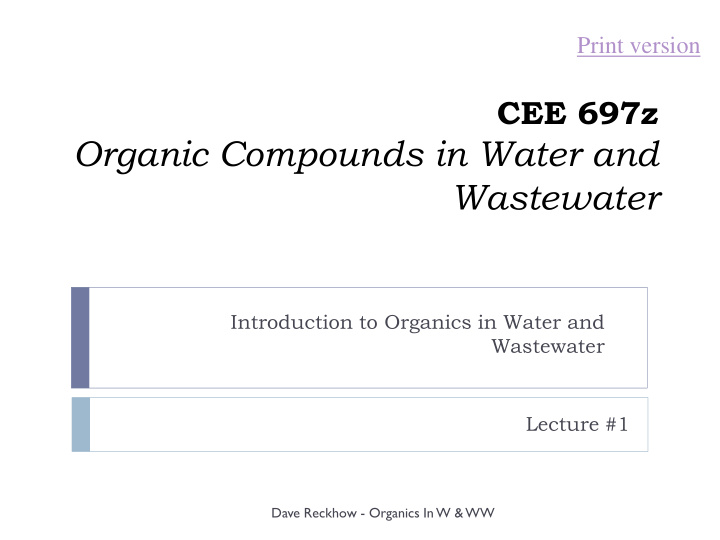



Print version CEE 697z Organic Compounds in Water and Wastewater Introduction to Organics in Water and Wastewater Lecture #1 Dave Reckhow - Organics In W & WW
Organic Compounds: Types? Natural Compounds Pharmaceuticals, etc Anti-epileptics Fulvics Beta-blockers Proteins, carbohydrates, etc X-ray contrast media Domestic WW Organics antibiotics Industrial Synthetic Organics Home & Personal Care Products Plasticizers: phthalates triclosan solvents: tetrachloroethylene Musks, flame retardants waxes: chlorinated parafins Endocrine Disrupters others: PCB’s Steroidal estrogens Hydrocarbons & oil Natural process byproducts derivatives Conjugated pharmaceuticals includes products of combustion: PAH’s Engineered process byproducts Agricultural Chemicals disinfection byproducts, etc pesticides: DDT, kepone, mirex Dave Reckhow - Organics In W & WW
Tentative plan Week of: T opic Sept 1 Introduction & Planning Sept 8 Sept 15 Natural Organic Matter Sept 22 Sept 29 Oct 6 Fracking Fluids Oct 13 Oct 20 PPCPs & Estrogenic Compounds Oct 27 Nov 3 Nov 10 Cyanotoxins Nov 17 Nov 24 Hydrophobic Toxins Dec 1 Dave Reckhow - Organics In W & WW
A brief history of Carbon 13,800,000,000 BCE: the big bang - now we have matter; and about 400,000 yrs later we have the first carbon atoms 1,600,000 BCE – human controlled fire; formation of charcoal 3750 BCE – Egyptians & Sumerians use charcoal for reducing Cu, Zn & Sn 150: “Vitalism” holds that living organisms are composed of “organic” material 1789: carbon recognized by Antoine Lavoisier as an element 1824: “Vitalism” is discredited and modern view of organic compounds begins to emerge 1840s: water pollution worsens in major urban centers 1858: tetravalent nature of carbon is recognized helping to launch modern organic chemistry Dave Reckhow - Organics In W & WW
Hamlin (1990) A Science of Impurity, University of California Press A Science of Impurity From Hamlin, 1990 Most chemical analysis of water in the early to mid 1800s was focused on mineral waters used almost exclusively by the rich
London The Great Stink Michael Faraday presenting his card to Father Thames Punch , July, 1855 Aside from using our noses, how to measure the organic matter? Halliday (1999) The Great Stink of London, Sir Joseph Bazalgette and the Cleansing of the Victorian Dave Reckhow - Organics In W & WW Metropolis, Sutton
Earliest Quantitative Methods Reaction with Oxidants Hg and Pb salts Early 1800s Permanganate & Dichromate Chemical oxygen demand Permanganate test developed by Forchhammer in 1850 (Denmark) Oxygen “catalyzed” by microorganisms Biochemical oxygen demand 1908 proposed BOD 5 as the best method for river pollution by the Royal Commission on Sewage Later standardized as it is today Color Dave Reckhow - Organics In W & WW
To next lecture Dave Reckhow - Organics In W & WW
Recommend
More recommend